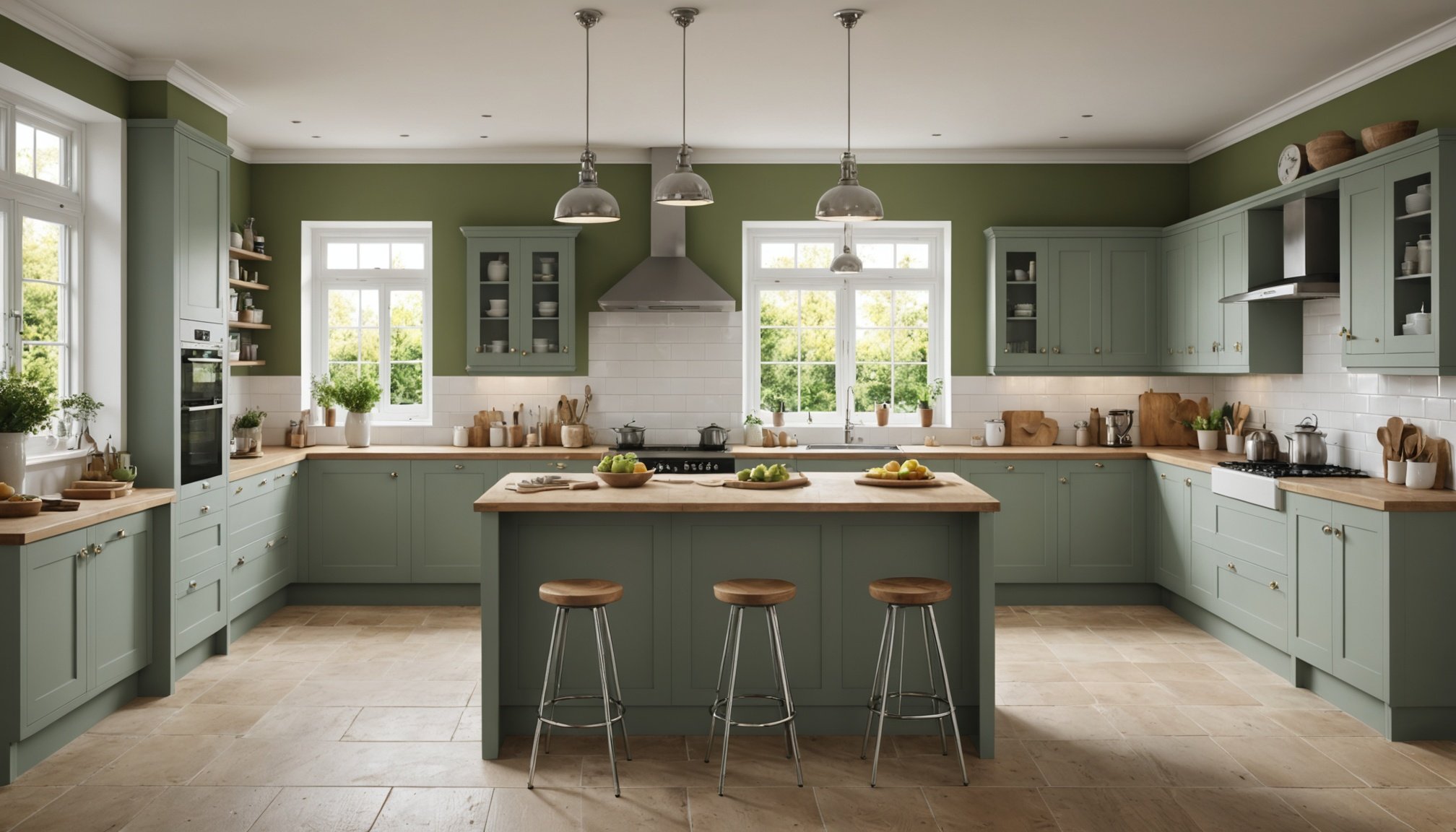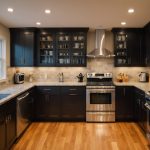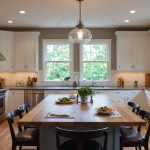Choosing the perfect wall color for your kitchen can transform the space, especially when it's bright and welcoming. With the right hue, you can enhance natural light, create a lively atmosphere, and reflect your personal style. This guide offers practical tips, inspiring ideas, and expert insights tailored for UK kitchens. Elevate your cooking space and make it truly yours by selecting a color that brings joy and functionality together.
Understanding Color Theory for Kitchen Spaces
Exploring the impact of color in kitchen design
In parallel : Top Vegan Protein Powders in the UK: Your Ultimate Kitchen Companion
Basics of Color Theory
Color theory is a fundamental guide in interior design, providing a framework for combining colors harmoniously. In kitchen spaces, understanding color theory helps in selecting hues that complement each other, ensuring a visually appealing environment. The color wheel, a core element of color theory, classifies colors into primary, secondary, and tertiary categories, aiding in the creation of balanced color palettes.
Psychological Effects of Colors
Colors have the power to influence our emotions and behaviors, a concept known as color psychology. For instance, warm colors like red and yellow can stimulate appetite and energy, making them popular choices for kitchens. Conversely, cool colors such as blue and green promote calmness and relaxation, ideal for creating a serene cooking space.
This might interest you : Top UK-Crafted Aprons Perfect for Professional Chefs: Discover the Ultimate in Culinary Comfort and Style!
Importance of Harmony
Achieving harmony in color selection is crucial for kitchen aesthetics. A well-coordinated color scheme not only enhances the visual appeal but also impacts the mood and functionality of the space. Designers often use a combination of complementary and analogous colors to create a cohesive look.
- Red: Stimulates appetite
- Blue: Promotes calmness
- Green: Encourages relaxation
By understanding and applying these principles, homeowners can transform their kitchens into inviting and functional spaces.
Best Color Choices for Bright UK Kitchens
Exploring vibrant options for enhancing kitchen spaces
Popular Color Choices
In contemporary UK kitchen designs, selecting the best kitchen colors involves understanding how hues can enhance brightness and space perception. Neutral tones like white and cream are perennial favorites, creating an open and airy feel. These colors reflect light effectively, making kitchens appear larger and more inviting.
Enhancing Brightness and Space Perception
Specific colors can significantly impact how spacious a kitchen feels. Light blues and soft yellows are trending colors that add a touch of warmth while maintaining a bright ambiance. These hues work well in smaller kitchens, where maximizing natural light is essential. By using these colors, homeowners can create a sense of openness and vitality in their kitchen spaces.
Trending Color Palettes
Current trends in UK kitchen designs embrace a mix of classic and modern color palettes. A popular choice is the combination of pastel shades with bold accents, such as navy or emerald green. This approach allows for creativity while ensuring the kitchen remains bright and welcoming.
- White and Cream: Timeless and reflective
- Light Blue: Expands space perception
- Pastel with Bold Accents: Modern and vibrant
Choosing the best kitchen colors can transform a mundane kitchen into a bright, lively area that enhances both style and functionality.
Practical Tips for Selecting Wall Colors
Guidance for creating the perfect kitchen ambiance
Importance of Testing Paint Samples
When choosing the ideal wall colors for your kitchen, testing paint samples in various lighting conditions is crucial. Light can dramatically alter how a color appears, so observe samples at different times of the day. This practice ensures that the chosen hue maintains its appeal and complements the overall kitchen design.
Pairing Wall Colors with Cabinetry and Decor
Selecting wall colors involves more than just personal preference. Consider how they pair with existing cabinetry and decor. A harmonious color scheme can enhance the kitchen's aesthetic and functionality. For example, neutral walls can balance bold cabinetry, while vibrant walls can add personality to minimalist designs.
Avoiding Common Pitfalls in Color Selection
Avoid common color selection mistakes by considering these tips:
- Overwhelming Brightness: Use bright colors sparingly to avoid overpowering the space.
- Clashing Tones: Ensure wall colors harmonize with other elements.
- Ignoring Undertones: Recognize undertones in paint samples to prevent unexpected results.
By thoughtfully selecting wall colors, you can create a kitchen that is both inviting and stylish. Remember, the right color choice not only enhances the space but also reflects your personal taste and lifestyle.
Enhancing Brightness with Lighting Considerations
Optimizing light for vibrant kitchen spaces
Role of Natural Light
Natural light plays a pivotal role in enhancing a kitchen's brightness and influencing wall color choices. Kitchens with ample sunlight can adopt a wider range of hues, as natural light tends to reveal the true tone of colors. It’s essential to consider window placements and the direction of sunlight when selecting colors. This ensures that the kitchen maintains a vibrant and welcoming atmosphere throughout the day.
Best Practices for Artificial Lighting
Incorporating artificial lighting effectively is crucial for maintaining brightness in kitchens, especially during evening hours or in spaces with limited natural light. Layered lighting, combining ambient, task, and accent lights, can create a balanced and well-lit environment. Use LED lights for energy efficiency and to enhance color reflection on surfaces, making the kitchen appear larger and more inviting.
Color Reflection and Perceived Brightness
The color reflection of walls and surfaces significantly impacts the perceived brightness in the kitchen. Light-colored walls reflect more light, amplifying the effect of both natural and artificial lighting. Consider the following:
- Reflective Surfaces: Enhance brightness
- Light Hues: Maximize light reflection
- Layered Lighting: Complements color reflection
By strategically utilizing lighting, kitchens can achieve an optimal balance of brightness and color harmony.
Successful Design Examples in UK Kitchens
Showcasing vibrant and harmonious kitchen interiors
Showcase of Successful UK Kitchen Designs
In the realm of kitchen design inspiration, several UK kitchens stand out for their effective use of color. These spaces demonstrate the practical application of color theory, creating environments that are both functional and aesthetically pleasing. One noteworthy example features a combination of soft greys and bold accents of mustard yellow, which highlights the kitchen's modern cabinetry and stainless-steel appliances.
Analysis of Design Elements
Successful designs often incorporate complementary elements that enhance bright wall colors. For instance, a kitchen with light blue walls might include white marble countertops and chrome fixtures, which reflect light and add depth. Another design might pair pastel pink walls with natural wood finishes, creating a warm and inviting atmosphere.
- Soft Greys: Versatile and modern
- Mustard Yellow Accents: Adds vibrancy
- White Marble: Reflects light
Lessons from Real-Life Applications
Real-life applications of color theory in kitchens reveal valuable lessons. Designers learn that balancing color with materials and finishes is key to achieving harmony. By studying these examples, homeowners can gain insights into creating their own inspiring kitchen spaces, ensuring that every element works together to enhance the overall design.
Maintaining and Updating Your Kitchen Colors
Ensuring your kitchen remains stylish and vibrant
Tips for Maintaining Wall Colors
Maintaining wall colors in high-traffic kitchen areas is essential for preserving their vibrancy and appeal. Regular cleaning using mild detergents can prevent grease and dirt build-up, which often dulls colors. Consider using semi-gloss or satin finishes that are easier to clean and more resistant to stains. This not only prolongs the life of your kitchen colors but also keeps the space looking fresh and inviting.
Trends in Color Updates
Staying updated with interior design trends can inspire you to refresh your kitchen space. Current trends favor bold, contrasting colors paired with neutral tones for a balanced look. Consider introducing accent walls or colorful backsplashes to rejuvenate your kitchen without a complete overhaul. This approach allows for easy updates in line with seasonal trends while maintaining a cohesive design.
Long-Term vs. Seasonal Trends
When selecting kitchen colors, weigh the benefits of long-term choices against seasonal trends. Long-term colors should offer timeless appeal and complement your lifestyle, while seasonal trends can be integrated through accessories like curtains or tableware. This strategy ensures your kitchen remains both trendy and practical.
- Semi-gloss Finishes: Easy to clean
- Accent Walls: Refresh without overhaul
- Timeless Appeal: Essential for long-term choices











